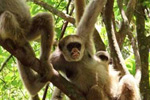The intensity of land-use influences the speed of regeneration in tropical rainforests, says new research. Tropical rainforests are a priority for biodiversity conservation; they are hotspots of endemism but also some of the most threatened global habitats. The Atlantic Forest stands out among tropical rainforests, hosting an estimated 8,000 species of endemic plants and more than 650 endemic vertebrates. However, only around 11 percent of these forests now remain. The quality of what remains is also a concern: 32 to 40 percent of remnants are small areas of secondary forest. Although the restoration of these secondary forests would go a long way toward mitigating the loss of forest cover and biodiversity elsewhere, it is not always possible to recover richness, diversity and floristic composition. Land-use history can make these changes irreversible.
Published in mongabay.com’s open access journal Tropical Conversation Science, the study surveyed the effects of different land-use histories on the restoration process of Atlantic rainforest areas, in the Michelin Ecological Reserve, Brazil.
“Disturbance history influenced the richness, diversity and the floristic composition of the disturbed forest studied,” wrote Rocha-Santos and Talora, lead authors of the study.

The Atlantic Forest outside of Rio de Janeiro. Photo by: Rhett A. Butler. |
The highest values of richness and diversity were found in areas with a history of low-impact logging. This area recorded 93 tree species from 35 families. Areas that suffered slash-and-burn agriculture returned 77 species from 38 families, while those with a history of high-impact logging had the lowest richness and diversity amongst the three land-use histories: its tree community structure comprised 75 species from 32 families.
“The area in recovery after low-impact logging showed the highest richness and diversity, indicating that this was the disturbance that allowed the fastest recover…on the other hand, the area subjected to high-impact logging showed the lowest richness and diversity, suggesting that the higher the intensity of exploitation, the longer the time required for the recovery of this forest’s characteristics,” said the authors.
While, the diversity of the slash-and-burn areas were similar to high-impact logging sites, previous research has shown that slash-and-burn areas only present low richness in the early years (5-20 years), and that after 40 to 60 years of recovery, these forests are similar in composition and diversity to those of less disturbed tropical forests. Studies in tropical forests also indicate that the greatest species dominance (where few species account for most of the coverage) is found in areas of an early successional stage. Areas subjected to selective logging, regardless of the intensity, appear to be in a more advanced stage of recovery than areas subjected to slash-and-burn. This was also recorded in African tropical forests. Enrichment actions may therefore be necessary to accelerate forest recovery in such forest remnants.
“Such actions may assist in the recovery of ecological processes such as nutrient cycling, biotic pollination and dispersal, which may have been corrupted by previous land-use”, concluded the authors.
The fact that only minor intervention is necessary in areas where forest cover is already established significantly reduces restoration costs. Political will aside, we have no excuses when it comes to the recovery of Atlantic rainforests.
CITATION: Rocha-Santos, L. and Talora, D. C. 2012. Recovery of Atlantic Rainforest areas altered by distinct land-use histories in northeastern Brazil. Tropical Conservation Science Vol. 5(4):475-494 .
Related articles
Endangered muriqui monkeys in Brazil full of surprises

(11/26/2012) On paper, the northern muriquis (Brachyteles hypoxanthus) look like a conservation comeback story. Three decades ago, only 60 of the gentle, tree-dwelling primates lived in a fragment of the Atlantic Forest along the eastern coast of Brazil. Now there are more than 300. But numbers don’t tell the whole story, according to anthropologist Karen Strier and theoretical ecologist Anthony Ives of the University of Wisconsin, Madison. The pair analyzed 28 years of data on the demographics of the muriquis, one of the longest studies of its kind. They found surprising patterns about birth and death rates, sex ratios, and even how often the monkeys venture out of their trees. These findings raise questions about the muriquis’ long-term survival and how best to protect them, the scientists wrote in the Sept 17 issue of PLoS ONE.
Happy Halloween: nine new species of tree-climbing tarantula discovered

(10/31/2012) If you suffer from acute arachnophobia, this is the perfect Halloween discovery for you: a spider expert has discovered nine new species of arboreal (tree-dwelling) tarantulas in the Brazil. Although tarantula diversity is highest in the Amazon rainforest, the new species are all found in lesser-known Brazilian ecosystems like the Atlantic Forest, of which less than 7 percent remains, and the cerrado, a massive savannah that is being rapidly lost to agriculture and cattle ranching.
Key mammals dying off in rainforest fragments

(08/15/2012) When the Portuguese first arrived on the shores of what is now Brazil, a massive forest waited for them. Not the Amazon, but the Atlantic Forest, stretching for over 1.2 million kilometers. Here jaguars, the continent’s apex predator, stalked peccaries, while tapirs waded in rivers and giant anteaters unearthed termites mounds. Here, also, the Tupi people numbered around a million people. Now, almost all of this gone: 93 percent of the Atlantic Forest has been converted to agriculture, pasture, and cities, the bulk of it lost since the 1940s. The Tupi people are largely vanished due to slavery and disease, and, according to a new study in the open access journal PLoS ONE, so are many of the forest’s megafauna, from jaguars to giant anteaters.
Deforestation in Brazil’s Mata Atlantica drops
(06/06/2012) Deforestation of Brazil’s Mata Atlântica — a forest ecosystem more threatened than the Amazon rainforest — fell to 133 square kilometers between 2010 and 2011, down about 14.7 percent from the annual average between 2008 and 2010, reports Brazil’s National Institute for Space Research (INPE) and Fundação SOS Mata Atlântica.







